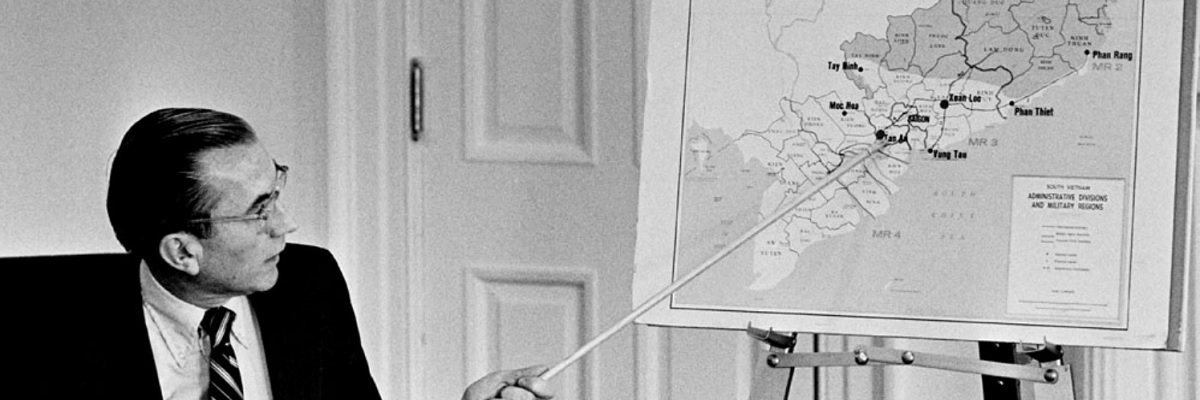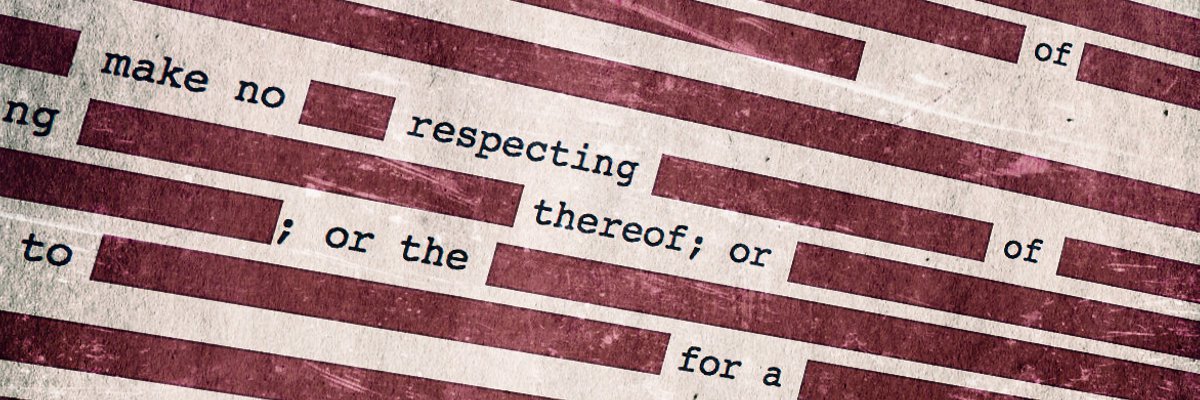Read Part One Here
While some outlets did briefly describe the Asia Foundation as being an alleged CIA conduit, the charges found in both the New York Times’ and CIA’s archives were vague and largely circumstantial, typically noting that TAF had funded a CIA affiliated group or received funds from one.
None of the archived reports specifically tied it to Agency funds until March 21, 1967 when TAF announced it in a limited hangout. A limited hangout, as aptly defined for the public by Victor Marchetti, is a technique used when the Agency “can no longer rely on a phony cover story to misinform the public, they resort to admitting - sometimes even volunteering - some of the truth while still managing to withhold the key and damaging facts in the case. The public, however, is usually so intrigued by the new information that it never thinks to pursue the matter further.”
That last part is essentially what happened in the case of the disclosure of The Asia Foundation’s ties to CIA. In fact, much of the reveal and the termination of direct CIA funding was planned well in advance. Documents show that as early as February and May of 1966, the Agency was looking to improve the financial cover of TAF “by means of a credible source of income.”

The following month, a declassified memo discusses the potential for exposure by Ramparts and the need to improve the covert funding of TAF.
The Agency felt that as a result of the New York Times’ series on the CIA, TAF faced additional challenges. In response, the 303 Committee met and discussed what to do about TAF’s financial cover. At this meeting, Cord Meyer noted “how a gadfly publication such as Ramparts had the capability to inflict considerable damage and apparently that was their intention.” The decision was made to begin improving TAF’s cover on a step-by-step basis to minimize the likelihood and impact of such any disclosure.

The meeting also affirmed that at that time, TAF’s activities continued to include covert coordination with CIA Stations in addition to the local embassies.
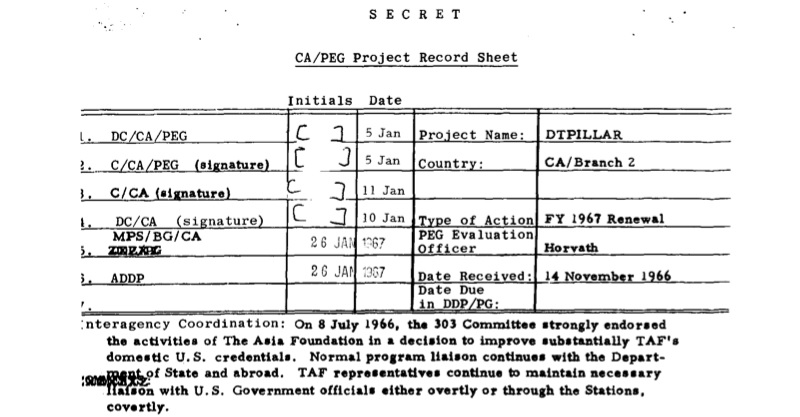
As early as November 1966, the Agency’s internal memos, now declassified, show concern about an exposure by Ramparts.

In January 1967, CIA received word that people were asking about The Asia Foundation’s funding for articles for Ramparts and the New York Times.
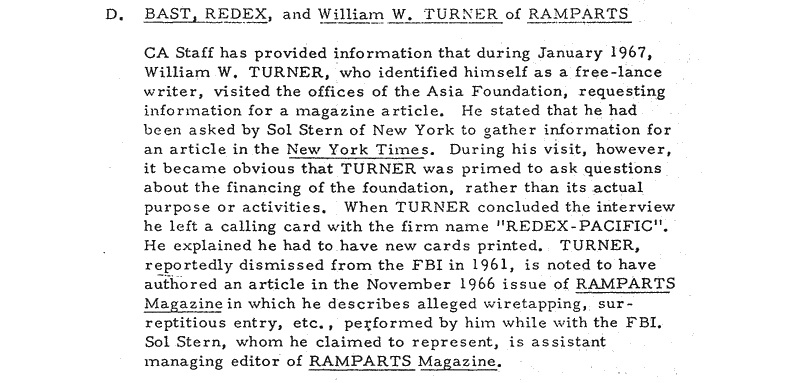
Source: Mary Ferrell
The Asia Foundation likely would have ignored the articles and rode out the wave of speculation, if not for the Katzenbach Committee’s recommendation that CIA funding to private organizations be cut off following the disclosures of the Agency’s financial ties to various groups. A declassified memo shows that “in anticipation” of this, TAF created a press release with the help of the CIA. The release was “a carefully limited statement of admission of past CIA support. In so doing the Trustees sought to delimit the effects of an anticipated exposure of Agency support by the American press and, if their statement or some future expose does not seriously impair TAF’s acceptability in Asia, to continue operating in Asia with overt private and official support.”
This statement had been prepared by March 19th and sent out to various TAF branches with the intention of publicly using it on, the 21st unless “unforeseen emergency” forced them (imminent independent exposure) to proceed with it on the 20th.
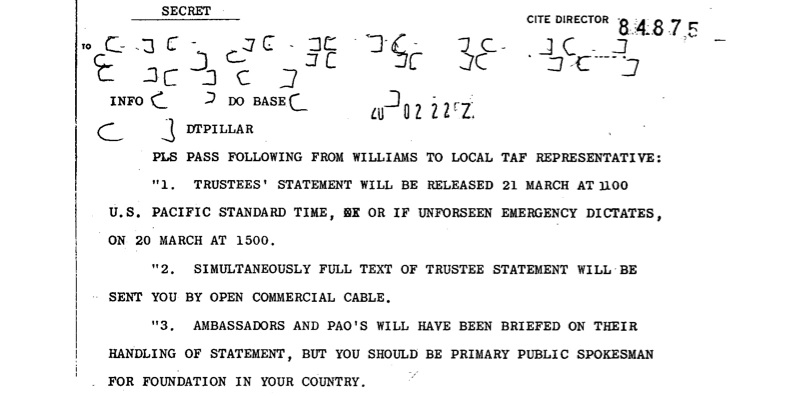
The cable authored by then-president of TAF Haydn Williams encouraged local offices to act surprised and deny that they or any of their staff had any awareness of or connection to CIA involvement.

As shown above, of course, this denial was not true - TAF staff members in the field performed intelligence functions and coordinated with the local CIA Station, and Williams knew it. A few years before, Williams had not only participated in but helped organize and deliver courses to TAF staff members “to better inform and integrate [them] into the Agency.”
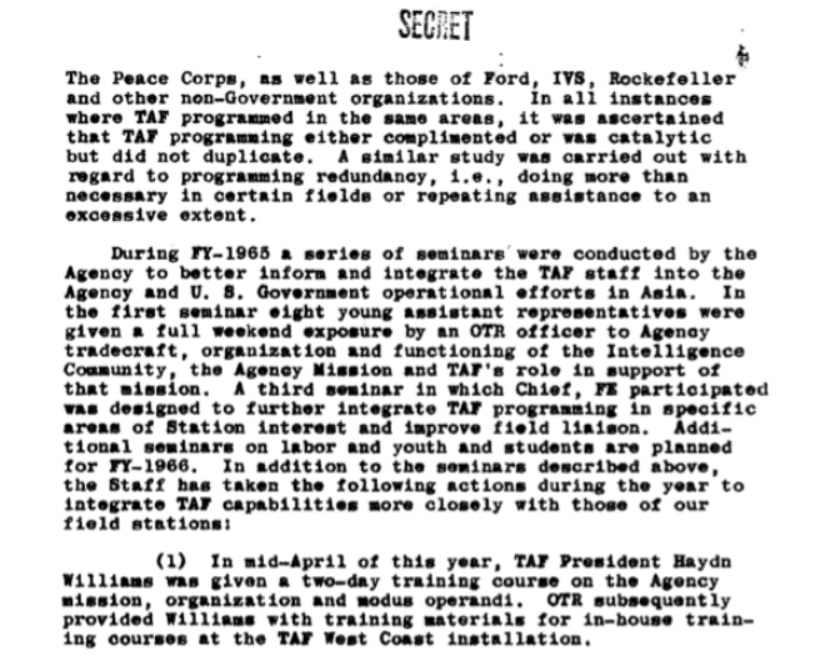
The press release put out by TAF was both vague and inaccurate. Among other things, it insisted that the group was founded in 1954.

Despite having been a public press release, only the first page was released in CIA’s archive. The next page of the document was withheld from CIA under exemption 25X1, claiming that it would reveal the Agency’s sources and methods. In articles published in response to the press release and accompanying statements, TAF asserted (falsely) that it had not been influenced by the CIA, and that while they had received CIA funds indirectly, but had been aware that it was “federal” money. In reality, the Agency was responsible for a significant portion of TAF’s funding, was its primary, if not sole, constituent, and had on at least one occasion passed money directly to TAF.
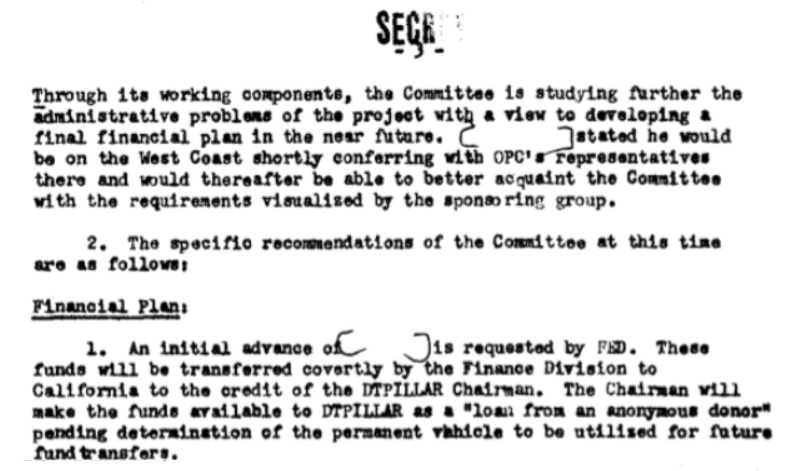
The statements also asserted that TAF was done taking covert funds and had severed their connections to CIA. Declassified documents show that this was false, and that TAF received additional payments from CIA to fund them through 1968 and well into 1969.
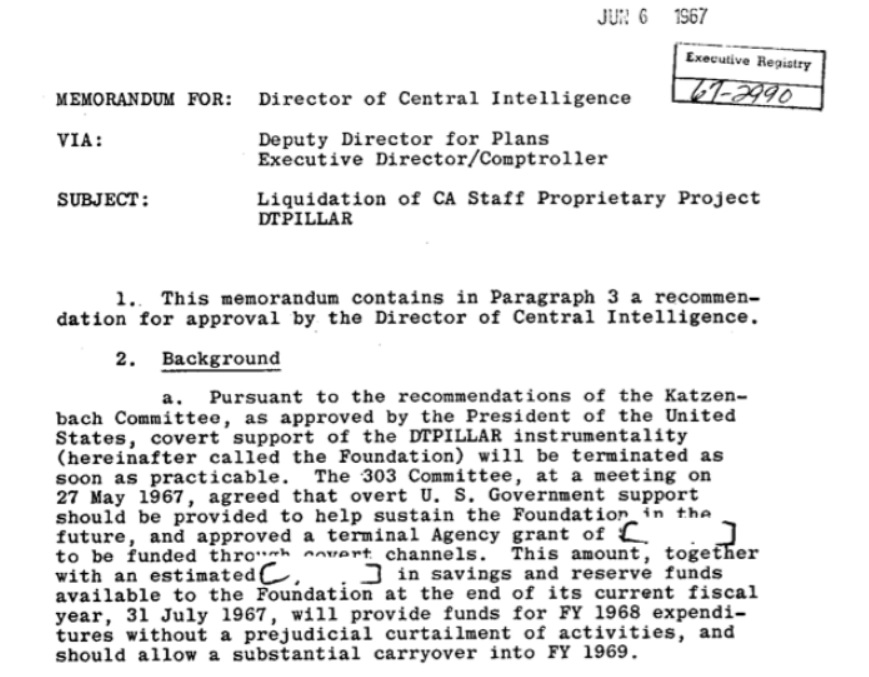
The plan to continue funding TAF for the following year was approved by the NSC Committee that helped CIA oversee TAF, according to a memo written to the Executive Director-Comptroller from John Clarke, CIA’s Director of Planning, Programming and Budgeting. At the same time, the CIA was to “terminate its relationship with the Foundation as soon as possible” while the State Department, which had a representative on the Special Group along with the CIA, would assume responsibility for liaising with TAF.

The memo went on to explain that transferring the funds several months after they were ordered to stop payments to private groups was the quickest way to terminate their relationship with TAF given the legal liabilities at play and the decision to secure alternative funding for TAF. Even the Katzenbach Committee, which recommended the termination of funds, had suggested December 31st as the cutoff date for such funding.
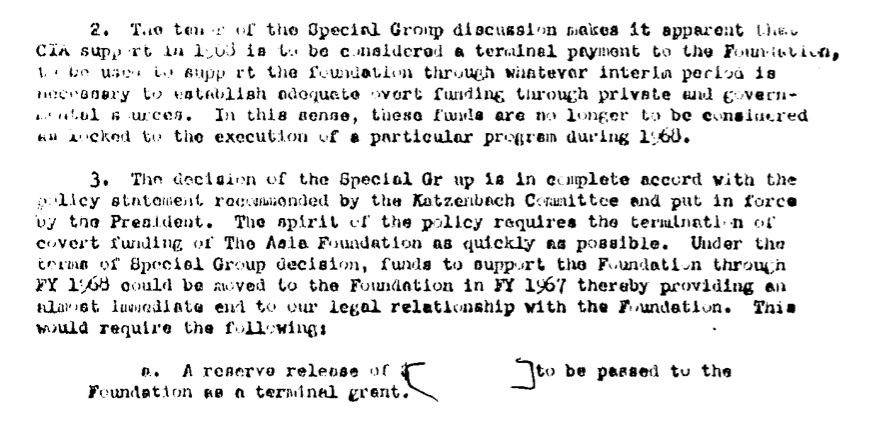
The Director of Planning did propose an alternative: waiting until 1968 and passing money to TAF then. Since this would have come with a number of risks to both CIA and TAF, as well as sending a bad impression to Congress, the Director of Planning recommended against it. Instead, the Agency should borrow against its funding for the following year to provide an additional surge of funds to TAF to support the foundation through 1968 and with “a substantial carryover into 1969.”
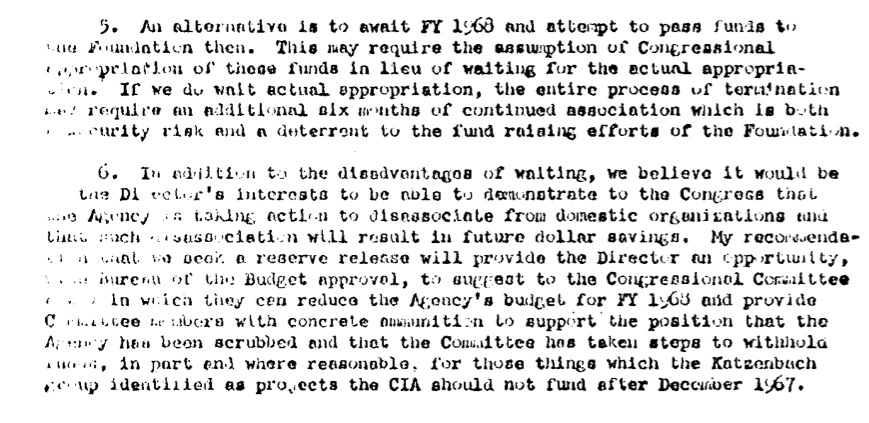
This was to be accomplished through TAF’s Liquidation Reserve Fund, which had been established by the Agency in 1954 and added to in the years since. Its purpose was straightforward - to put enough into TAF’s bank accounts that the organization would be able to meet “all actual or contingent liabilities which would exist in the event [of] unforeseen circumstances necessitated [sic] the abrupt termination of CIA’s underwriting of the DTPILLAR program.” Other documents explain that this included ongoing expenses, overhead, termination pay and the costs associated with returning personnel to the United States if the TAF were forced to end its operations.
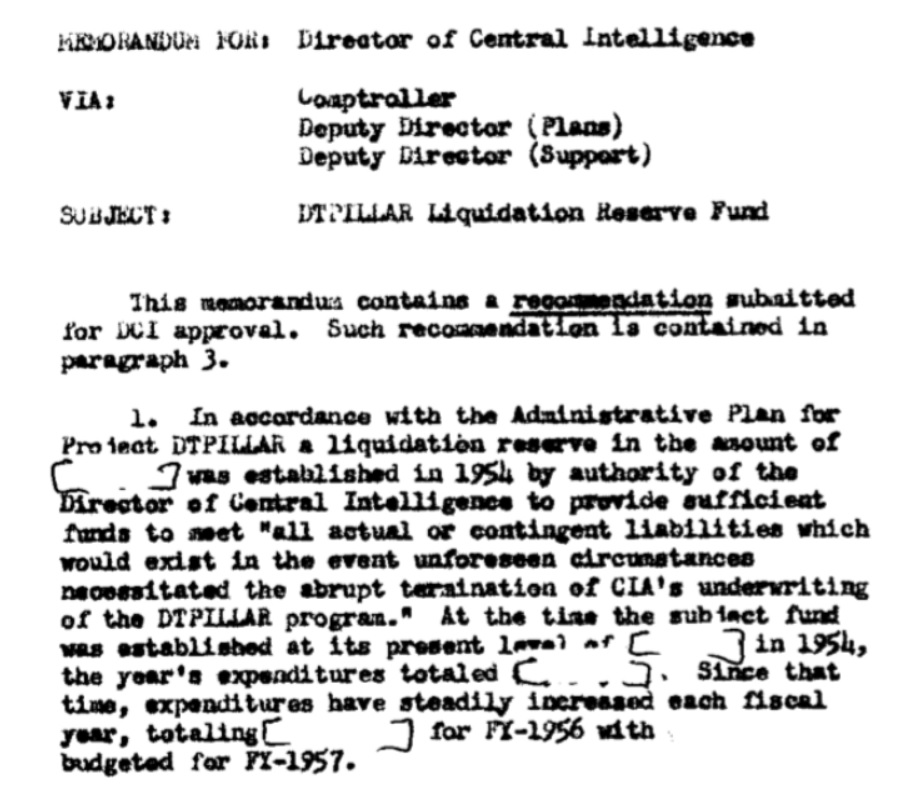
While the final transfer of funds was originally scheduled to take place at the end of July, it appears that the final transfer wasn’t performed until the middle of August. This date, while a technicality, is significant for groups like CIA and TAF which can thrive on technicalities and legal loopholes. According to CIA’s files, July 31st was the end of FY 1967 for TAF. This means that The Asia Foundation accepted CIA funds as late as FY 1968, with the intention of using those funds through 1968 and 1969.
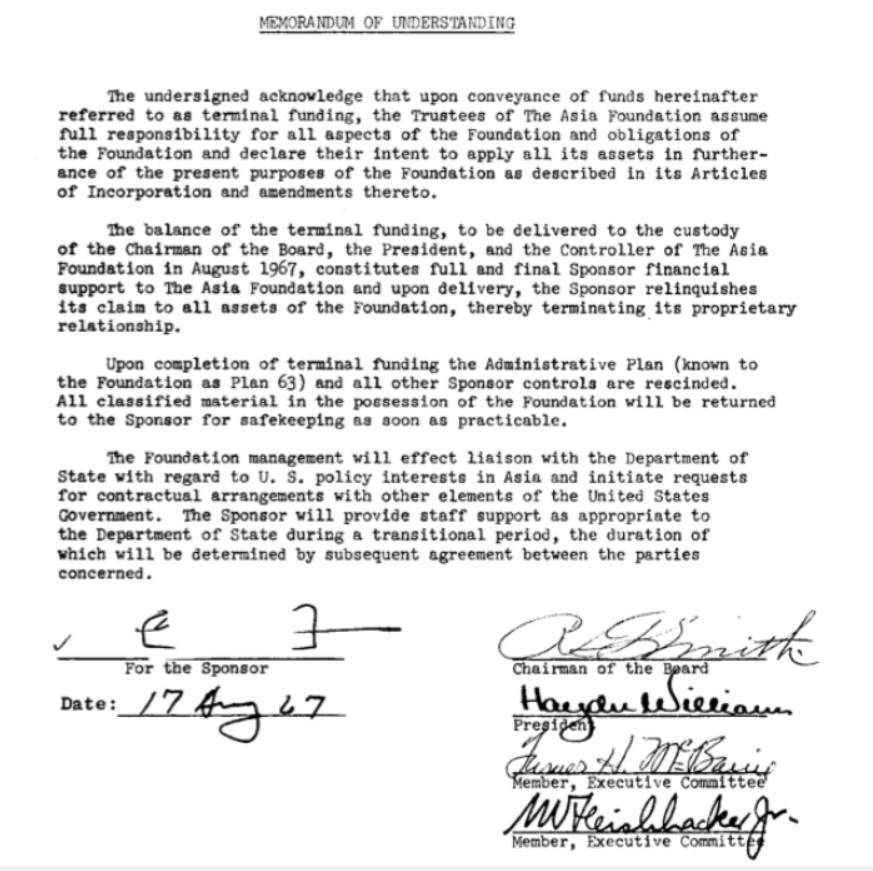
Even with the “final” transfer complete, the Agency was pursuing options that would have allowed it to keep organizations like TAF under CIA control despite the Katzenbach policy. Radio Free Europe and Radio Liberty, which bore deliberate similarities to TAF’s Radio Free Asia, would seem to have been included in the Katzenbach policy. An Agency memo, however, pointed out that the Radios were “created entities” and “not voluntary organizations in the usual sense. … Therefore, [they] should not be considered under the Katzenbach policy.”

Another memo from the same time period put forth another suggestion for RFE/RL, one which could apply to TAF or any other entity that was seemingly affected by the Katzenbach policy. According to this memo, they could complete the surge funding they were providing to RFE/RL, similar to the surge funding they were providing to TAF, and then terminate the funding. According to the memo, this “technically concluded CIA’s financial relationship in compliance with the Katzenbach Committee doctrine … and left open the way to future resumption by the Agency of covert financial responsibility.” In other words, the Agency was more than willing to technically stop the funding and then resume it. A third memo declares that RFE/RL were the only groups that carried out this strategy

Documents in CIA’s archive show that the Agency’s interest in TAF’s funding was ongoing following the dissolution of the Agency’s direct sponsorship. When Henry Kissinger was asked to help encourage additional over government funding for TAF in 1969, when CIA’s funds would have been running out, the Agency saved the information as one of the “equities” which they had partial ownership of. The only mention of CIA in the document refers to public disclosures.
Throughout the 70s and into the 80s, The Asia Foundation stayed in contact with CIA, with the most ample documentation on it relating to government funding for TAF. From a 1981 meeting between the CIA Director and TAF’s President to the Agency’s interest in the State Department’s quest to secure permanent funding for TAF (the same quest which produced the misleading paper incorporated into the 1983 CRS report and the subsequent Asia Foundation Act), to direct encouragement from the CIA Director to provide TAF with funding, the Agency was in the background. Curiously, in the leadup to the early ’80s effort to secure permanent funding for TAF, Haydn Williams acknowledged to the President of the United States that the group was founded in 1951 and not 1954, as the Trustees would later imply in the Trustees’ paper to the State Department.
That TAF continued to consult with CIA is hardly a surprise, given the fact that TAF was to continue to consult with the NSC’s 303 Committee. According to the 1967 Liquidation Plan, the 303 Committee would appoint a State Department officer “to act as liaison with the Foundation on matters of national interest and as coordinator for negotiations between the Government and the Foundation on matters of overt support” following the disassociation from the Agency. CIA’s explicit involvement would be ongoing “for as long as is required” in the form of an Agency officer “knowledgeable of the project and Foundation affairs.” The NSC’s 303 Committee, which TAF would continue to consult with, was composed of representatives from the Departments of Defense and State along with CIA.

Since the dissolution of the Agency’s direct relationship, TAF has sought to slowly distance themselves from their origins with the Agency. In some instances, this means TAF simply omits several years of its history. In other instances, TAF makes inaccurate claims about its relationship with CIA and insist that it was more limited than the record shows. In others, this means articles written in part by but not attributed to TAF. Consciously or not, TAF’s information about its history is now frequently recycled and regurgitated by others.
In perhaps the most typically modern example of all, a Wikipedia article written by an anonymous editor using multiple IP addresses. These IP addresses belong to locations spread across the country, with their edits made within minutes of one another. The second IP address resumed where the first one let off in the text. The timing and similarity of the edits imply that they were performed by a single editor who changed their public IP address.
Edits from both IP addresses took text directly from TAF publications, often with little to no editing. In some instances, the text was copied one sentence at a time and mixed together. In others, entire paragraphs were copy and pasted. Almost none of the edits reference TAF’s website, including where text extensively quoting from it was added. One of the page’s established Wikipedia editors labeled the results of these edits as being “written like an advertisement.” These edits began with removing information about TAF’s origins and CIA connections and proceeded to replace it with inaccurate information copied from TAF’s website.
Perhaps most significantly, TAF’s desire to distance itself from its CIA origins has lead it to mislead the public about its current sources of funding. To celebrate what they called TAF’s 60th anniversary in 2014 (in actuality it was the 60th anniversary of the name), TAF released “Six Decades in Asia.” In it, TAF provided some inaccurate information about its past and claimed that “the Foundation has a robust and diversified funding base. In addition to federally appropriated U.S. funding, the Foundation receives nearly half its support from a wide range of private and corporate philanthropies, and the international development agencies of more than a dozen nations.” This statement is contradicted by the foundation’s own financial filings.
Filings show that in 2014, TAF received more than 85% of its funding from the USG. While the Asia Foundation Act provides funding to cover TAF’s core operational expenses, their government supported budget goes well beyond that through grants and other government programs. The year before, it had received nearly 93% of its funding from the USG and 90% the year before that. As shown in the chart below, in the past fifteen years, TAF had only received such a small portion of its funding from non-USG sources in 2001, and again in 2005.

TAF portrays itself as having been created “with the approval of the National Security Council” and later being funded by, but remaining functionally independent from, the CIA. In reality, it was a weapon crafted by CIA explicitly for political warfare. Armed with CIA propaganda products, guided by CIA priorities, staffed with CIA contract employees and former CIA staffers, TAF spent the first 16 years of its existence under the direct control of the Agency. For more than a year after that, it relied on funds that the Agency had covertly provided. TAF did not lose touch with the Agency in the following decades, nor did it lose its support.
While TAF has done good work, it also misleads the public about its origins with CIA, and about the current source of its funding. CIA’s administrative file clearly shows, however, that the foundation was staffed and controlled by the Agency. At least two of its Presidents, Greene and Blum, had worked with the Intelligence Community on projects that laid the groundwork for the CFA/TAF, including the project proposal itself and the NSC Directives it relied on. They, like all of TAF’s early Presidents, were CIA contract employees, and it wouldn’t be until 1989 that TAF had a President who wasn’t hand selected by the Agency. While TAF handled its own day to day operations, the chain of command was clear: the foundation had been owned and operated by CIA for more than a decade and a half, despite the denials offered by the foundation, which the leadership knew to false.
Despite their extremely deep ties, it is very likely that TAF’s relationship with CIA did significantly change. While they would continue to communicate and coordinate, and the foundation would do the best to make itself useful to the Agency if needed, there were already those in the Agency who felt that, given the cost, it was not effective as a “covert political action instrument except in rare cases.” In light of this, it seems unlikely that TAF would have continued to be used for covert political action, except perhaps in rare cases.

Virtually all agreed, however, that the foundation was very useful to the U.S.’ policy goals and should continue to receive U.S. government support, which has recently reached over $100,000,000 in a single year.
While there is nothing inherently wrong with TAF’s history and they did not break any (U.S.) laws, organizations like TAF should embrace the full truth. By rejecting parts of it, our collective history is distorted. When the Agency’s involvement is revealed, people are likely to assume the worst, creating an environment ripe for conspiracy theories and suspicion. TAF can only continue to be seen as acting in good faith if it openly and honestly embraces its full history - including the years before 1954 - and its origins with CIA.
Like Emma Best’s work? Support her on Patreon.
Image by CIA Flickr
